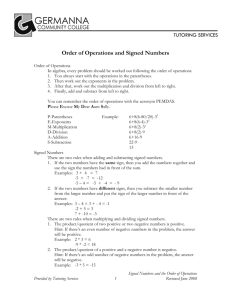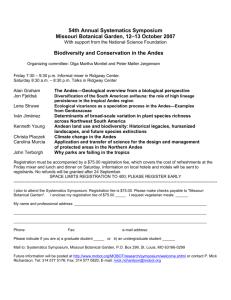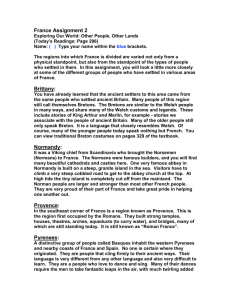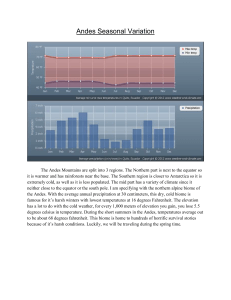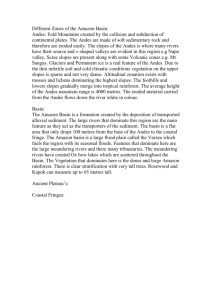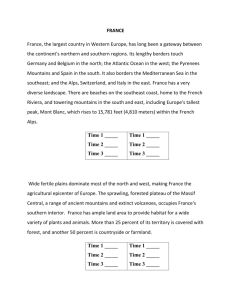Using the Hint Factory to Compare Model
advertisement
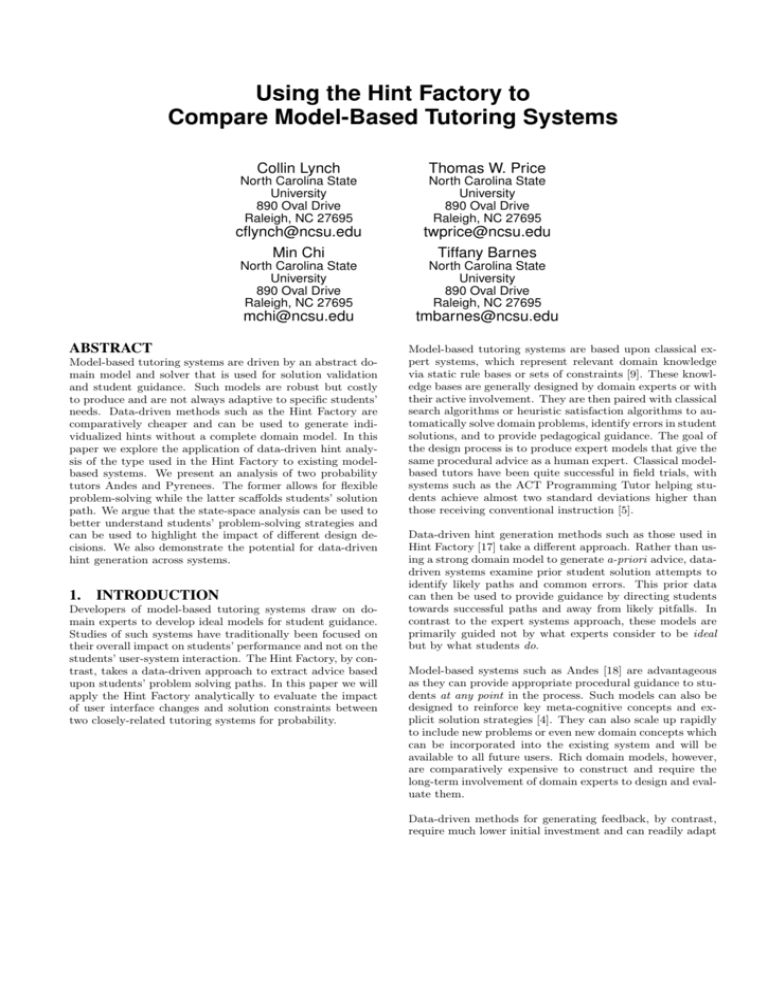
Using the Hint Factory to
Compare Model-Based Tutoring Systems
Collin Lynch
Thomas W. Price
North Carolina State
University
890 Oval Drive
Raleigh, NC 27695
North Carolina State
University
890 Oval Drive
Raleigh, NC 27695
cflynch@ncsu.edu
Min Chi
twprice@ncsu.edu
Tiffany Barnes
North Carolina State
University
890 Oval Drive
Raleigh, NC 27695
North Carolina State
University
890 Oval Drive
Raleigh, NC 27695
mchi@ncsu.edu
tmbarnes@ncsu.edu
ABSTRACT
Model-based tutoring systems are driven by an abstract domain model and solver that is used for solution validation
and student guidance. Such models are robust but costly
to produce and are not always adaptive to specific students’
needs. Data-driven methods such as the Hint Factory are
comparatively cheaper and can be used to generate individualized hints without a complete domain model. In this
paper we explore the application of data-driven hint analysis of the type used in the Hint Factory to existing modelbased systems. We present an analysis of two probability
tutors Andes and Pyrenees. The former allows for flexible
problem-solving while the latter scaffolds students’ solution
path. We argue that the state-space analysis can be used to
better understand students’ problem-solving strategies and
can be used to highlight the impact of different design decisions. We also demonstrate the potential for data-driven
hint generation across systems.
1.
INTRODUCTION
Developers of model-based tutoring systems draw on domain experts to develop ideal models for student guidance.
Studies of such systems have traditionally been focused on
their overall impact on students’ performance and not on the
students’ user-system interaction. The Hint Factory, by contrast, takes a data-driven approach to extract advice based
upon students’ problem solving paths. In this paper we will
apply the Hint Factory analytically to evaluate the impact
of user interface changes and solution constraints between
two closely-related tutoring systems for probability.
Model-based tutoring systems are based upon classical expert systems, which represent relevant domain knowledge
via static rule bases or sets of constraints [9]. These knowledge bases are generally designed by domain experts or with
their active involvement. They are then paired with classical
search algorithms or heuristic satisfaction algorithms to automatically solve domain problems, identify errors in student
solutions, and to provide pedagogical guidance. The goal of
the design process is to produce expert models that give the
same procedural advice as a human expert. Classical modelbased tutors have been quite successful in field trials, with
systems such as the ACT Programming Tutor helping students achieve almost two standard deviations higher than
those receiving conventional instruction [5].
Data-driven hint generation methods such as those used in
Hint Factory [17] take a different approach. Rather than using a strong domain model to generate a-priori advice, datadriven systems examine prior student solution attempts to
identify likely paths and common errors. This prior data
can then be used to provide guidance by directing students
towards successful paths and away from likely pitfalls. In
contrast to the expert systems approach, these models are
primarily guided not by what experts consider to be ideal
but by what students do.
Model-based systems such as Andes [18] are advantageous
as they can provide appropriate procedural guidance to students at any point in the process. Such models can also be
designed to reinforce key meta-cognitive concepts and explicit solution strategies [4]. They can also scale up rapidly
to include new problems or even new domain concepts which
can be incorporated into the existing system and will be
available to all future users. Rich domain models, however,
are comparatively expensive to construct and require the
long-term involvement of domain experts to design and evaluate them.
Data-driven methods for generating feedback, by contrast,
require much lower initial investment and can readily adapt
to individual student behaviors. Systems such as the Hint
Factory are designed to extract solutions from prior student
data, to evaluate the quality of those solutions, and to compile solution-specific hints [17]. While this avoids the need
for a strong domain model, it is limited to the space of solutions explored by prior students. In order to incorporate
new problems or concepts it is necessary to collect additional
data. Additionally, such methods are not generally designed
to incorporate or reinforce higher-level solution strategies.
We believe that both of these approaches have inherent advantages and are not necessarily mutually exclusive. Our
goal in this paper is to explore what potential data-driven
methods have to inform and augment model-based systems.
We argue that data-driven methods can be used to: (1)
evaluate the differences between closely-related systems; (2)
assess the impact of specific design decisions made in those
systems for user behaviors; and (3) evaluate the potential application of data-driven hint generation across systems. To
that end we will survey relevant prior work on model-based
and data-driven tutoring. We will describe two closelyrelated tutoring systems and data collected from them. We
will then present a series of analyses using state-based methods and discuss the conclusions that we drew from them.
2.
2.1
BACKGROUND
Model-Based Tutoring
Model-based tutoring systems take a classical expert-systems
approach to tutoring. They are typically based upon a
strong domain model composed of declarative rules and facts
representing domain principles and problem-solving actions
coupled with an automatic problem solver. This knowledge
base is used to structure domain knowledge, define individual problems, evaluate candidate solutions, and to provide
student guidance. Novices typically interact with the system
through problem solving with the system providing solution
validation, automatic feedback, pedagogical guidance, and
additional problem-solving tasks. The Sherlock 2 system, for
example, was designed to teach avionics technicians about
appropriate diagnostic procedures [11]. The system relies on
a domain model that represents the avionics devices being
tested, the behavior of the test equipment, and rules about
expert diagnostic methods. Sherlock 2 uses these models
to pose dynamic challenges to problem solvers, to simulate
responses to their actions, and to provide solution guidance.
Andes [19, 18, 20] and Pyrenees [4] are closely-related modeldriven ITSs in the domains of physics and probability. They
were originally developed at the University of Pittsburgh under the Direction of Dr. Kurt VanLehn. Like other modelbased systems, they rely on a rule-based domain model and
automatic problem solvers that treat the domain rules as
problem-solving steps. They distinguish between higherlevel domain concepts such as Bayes’ Rule, and atomic steps
such as variable definitions. Principles are defined by a central equation (e.g. p(A|B) = (p(B|A) ∗ p(A))/p(B)) and
encapsulate a set of atomic problem-solving steps such as
writing the equation and defining the variables within it.
The systems are designed to function as homework-helpers,
with students logging into the system and being assigned or
selecting one of a set of predefined problems. Each problem
Figure 1: The Andes user interface showing the
problem statement window with workspace on the
upper left hand side, the variable and equation windows on the right hand side, and the dialogue window on the lower left.
is associated with a pre-compiled solution graph that defines
the set of possible solutions and problem-solving steps. The
system uses a principle-driven automated problem solver to
compile these graphs and to identify the complete solution
paths. The solver is designed to implement the Target Variable Strategy (TVS), a backward-chaining problem solving
strategy that proceeds from a goal variable (in this case
the answer to the problem) via principle applications to the
given information. The TVS was designed with the help of
domain experts and guides solvers to define basic solution
information (e.g. given variables) and then to proceed from
the goal variable and use principles to define it in terms of
the given variables.
Students working with Andes use a multi-modal user interface to write equations, define variables and engage in other
atomic problem-solving steps. A screenshot of the Andes UI
can be seen in Figure 1. Andes allows students to solve problems flexibly, completing steps in any order so long as they
are valid [20]. A step is considered to be valid if it matches
one or more entries in the saved solution paths and all necessary prerequisites have been completed. Invalid steps are
marked in red, but no other immediate feedback is given.
Andes does not force students to delete or fix incorrect entries as they do not affect the solution process. In addition to validating entries, the Andes system also uses the
precompiled solution graphs to provide procedural guidance
(next-step-help). When students request help, the system
will map their work to the saved solution paths. It will then
select the most complete solution and prompt them to work
on the next available step.
One of the original goals of the Andes system was to develop a tutor that operated as an “intelligent worksheet.”
The system was designed to give students the freedom to
solve problems in any order and to apply their preferred
solution strategy. The system extends this freedom by allowing invalid steps in an otherwise valid solution and by
allowing students to make additional correct steps that do
not advance the solution state or are drawn from multiple
state of a student’s partial solution at some point during the
problem solving process, and each edge represents an action
that takes the student from one state to another. A complete
solution is represented as a path from the initial state to a
goal state. Each state in the interaction network is assigned
a weight via a value-iteration algorithm. A new student requesting a hint is matched to a previously observed state and
given context-sensitive advice. If, for example, the student is
working on a problem that requires Bayes’ Rule and has already defined p(A), p(B), and p(B|A) then the Hint Factory
would first prompt them to consider defining p(A|B), then
it would point them to Bayes Rule, before finally showing
them the equation p(A|B) = (p(B|A) ∗ p(A))/p(B).
Figure 2: The Pyrenees user interface showing the
problem statement at the top, the variable and equation lists on the left, and the tutor interaction window with calculator on the lower right.
solution paths. This was motivated in part by a desire to
make the system work in many different educational contexts where instructors have their own preferred methods
[20]. The designers of Andes also consciously chose only to
provide advice upon demand when the students would be
most willing to accept it. For the students however, particularly those with poor problem-solving skills, this passive
guidance and comparative freedom can be problematic as it
does not force them to adhere to a strategy.
This problem motivated the development of Pyrenees. Pyrenees, like Andes acts as a homework helper and supports students with on-demand procedural and remediation help. It
uses an isomorphic domain model with the same principles,
basic steps, problems, and solution paths. Unlike Andes,
however, Pyrenees forces students to applying the targetvariable-strategy during problem solving. It also requires
them to repair incorrect entries immediately before moving
on. Students are guided through the solution process with
a menu-driven interface, shown in Figure 2. At each step,
the system asks students what they want to work on next
and permits them to make any valid step that is consistent
with the TVS. Chi and VanLehn [3] conducted a study of the
two systems and found that scaffolding the TVS in Pyrenees
helped to eliminate the gap between high and low learners.
This effect was observed both in the original domain where
it was taught (in their case probability) and it transferred to
a new domain (physics), where students used Andes alone.
2.2
Data-Extraction and
Data-Driven Tutoring.
One of the longstanding goals of educational data-miners is
to support the development of data-driven tutoring systems.
Such systems use past student data to structure pedagogical
and domain knowledge, administer conceptual and pedagogical advice, or evaluate student performance and needs. A
number of attempts have been made to address these goals.
One of the most successful data-driven systems is the Hint
Factory [1, 2, 17]. The Hint Factory takes an MDP-based
approach to hint generation. It takes as input a set of prior
student logs for a given problem, represented as a network of
interactions [6, 7]. Each vertex in this network represents the
These hints are incorporated into existing tutoring systems
in the form of a lookup table that provides state-specific
advice. When a user asks for help the tutor will match their
current state to an index state in the lookup table and will
prompt them to take the action that will lead them to the
highest value neighboring state. If their current state is not
found then the tutor will look for a known prior state or
will give up. The Hint Factory has been applied successfully
in a number of domains including logic proofs [17], data
structures [8], and programming [15, 10, 13]. Researchers
have also explored other related methods for providing datadriven hints. These include alternative state representations
[13], path construction algorithms [16, 14], and examplebased model-construction [12].
The primary goal of the Hint Factory is to leverage prior
data to provide optimal state-specific advice. By calculating
advice on a per-state basis, the system is able to adapt to
students’ specific needs by taking into account both their
current state and the paths that they can take to reach the
goal. As a consequence the authors of the Hint Factory
argue that this advice is more likely to be in the students’
Zone of Proximal Development and thus more responsive to
their needs than a less-sensitive algorithm.
3.
METHODS
In order to investigate the application of data-driven methods to model-based tutoring systems, we collected data from
two studies conducted with Andes and Pyrenees in the domain of probability. We then transformed these datasets
into interaction networks, consisting of states linked with
actions. We used this representation to perform a variety of
quantitative and qualitative analyses with the goal of evaluating the differences between the two systems and the impact of the specific design decisions that were made in each.
3.1
The Andes and Pyrenees Datasets
The Andes dataset was drawn from an experiment conducted at the University of Pittsburgh [3]. This study was
designed to assess the differential impact of instruction in
Andes and Pyrenees on students’ meta-cognitive and problemsolving skills. Participants in this study were college undergraduates who were required to have taken high-school level
algebra and physics but not to have taken a course in probability or statistics. The participants were volunteers and
were paid by time not performance.
Forty-four students completed the entire study. However
for the purposes of the present analysis, we drew on all
66 students who completed at least one problem in AndesProbability. This is consistent with prior uses of the Hint
Factory which draw from all students including those who
did not complete the problem. The Pyrenees-Probability
logs from this study were not used due to problems with the
data format that prevented us from completing our analysis.
From this dataset we drew 394 problem attempts covering
11 problems. The average number of steps required to solve
the problems was 17.6. For each problem we analyzed between 25 and 72 problem attempts, with an average of 35.8
attempts per problem. Some attempts were from the same
student, with at most two successful attempts per student.
Over all problems, 81.7% of the attempts were successful,
with the remainder being incomplete attempts.
The Pyrenees dataset was drawn from a study of 137 students conducted in the 200-level Discrete Mathematics course
in the Department of Computer Science at North Carolina
State University. This study used the same probability textbook and pre-training materials as those used in the Andes
study. The students used Pyrenees as part of a homework
assignment, in which they completed 12 problems using the
tutoring system. One of these problems was not represented
in the Andes dataset. We therefore excluded it from our
analysis, leaving 11 shared problems.
Unlike the Andes students, however, the Pyrenees students
were not always required to solve every problem. In this
study the system was configured to randomly select some
problems or problem steps to present as worked examples
rather than as steps to be completed. In order to ensure
that the results were equivalent we excluded the problemlevel worked examples and any attempt with a step-level
worked example from our analysis. As a consequence, each
problem included a different subset of these students. For
each problem we analyzed between 83 and 102 problem attempts, with an average of 90.8 attempts per problem. Some
attempts were from the same student, with at most one successful attempt per student. Over all problems, 83.4% of
the attempts were successful.
3.2
State and Action Representations
In order to compare the data from both tutors, we represented each problem as an interaction network, a representation used originally in the Hint Factory [7]. In the network a vertex, or state, represents the sum total of a students’ current problem solving steps at a given time during
a problem-solving attempt. Because Andes permits flexible
step ordering while Pyrenees does not, we chose to represent
the problem solving state st as the set of valid variables and
equations defined by the student at time t.
A variable is a probabilistic expression, such as P (A ∪ B),
that the student has identified as important to solving the
problem, for which the probability is known or sought. An
equation represents the application of a principle of probability, which relates the values of defined variables, such as
the Complement Theorem, P (A) + P (¬A) = 1. Because
such equations can be written in many algebraically equivalent ways, we represent each equation as a 2-tuple, consisting of the set of variables included in the equation (e.g.
{P (A), P (¬A)}) and the principle being applied (e.g. Complement Theorem). Because we only represent valid equa-
tions, this representation uniquely identifies any equation
for a given problem. Because we used the same state representation for both tutors, we were able to compare states
directly across tutors.
Additionally, we opted to ignore incorrect entries. Pyrenees
prevents students from applying the principles of probability improperly and forces them to correct any mistakes made
immediately therefore any errors in the student logs are immediately removed making the paths uninformative. Andes,
by contrast, gives students free reign when writing equations
and making other entries. This freedom resulted in syntactic errors and improper rule application errors arising in our
dataset. The meaning of these invalid equations is inherently
ambiguous and therefore difficult to incorporate into a state
definition. However such errors are immediately flagged by
the system and may be ignored by the student without consequence as they do not affect the answer validity therefore
they may be safely ignored as well.
An edge, or action, in our network represents the correct
application of a rule or a correct variable definition and leads
to a transition from one state to another. For the present
dataset and state representation, the possible actions were
the definition or deletion of variables or equations. Each of
these actions was possible in both tutors.
4.
ANALYSIS
In order to develop a broader understanding of our datasets,
we first visualized the interaction network for each problem
as a weighted, directed graph. We included attempts from
both Andes and Pyrenees in the network, and weighted the
edges and verticies by the frequency with which it appeared
in the logs. We annotated each state and edge with the
weight contributed by each tutor. Two examples of these
graphs are given in Figure 3.
Throughout this section, we will use these graphs to address
the points we outlined at the end of Section 1. We begin
with a case study from one problem and will explore the
student problem solving strategies using our graph representation. We will then compare the Andes and Pyrenees
Systems with a variety of metrics based on this representation. We will relate our observations back to the design
decisions of each system and identify evidence that may support or question these decisions. Finally, we will show how
the analysis methods associated with data-driven hint generation can be used to validate some of these findings.
4.1
Case Study: Problem Ex242
The graphical representation of a problem is very helpful for
giving a high-level overview of a problem and performing
qualitative analysis. Problem Ex242, shown in Figure 3,
presents an interesting scenario for a number of reasons. The
problem was the 10th in a series of 12 practice problems, and
asked the following:
Events A, B and C are mutually exclusive and
exhaustive events with p(A) = 0.2 and p(B) =
0.3. For an event D, we know p(D|A) = 0.04,
p(D|B) = 0.03, and p(C|D) = 0.3. Determine
p(B|D).
clude them as they represent a fair proportion of the Andes
data. For instance, 62 of the 126 Andes states for Ex242
were singleton states.
Interestingly, while there were small variations among their
solutions, all of the Andes students choose to apply Bayes’
Rule rather than relying solely on the Conditional Probability Theorem as suggested by Pyrenees. This, coupled with
the strong proportion of Pyrenees students who also chose
the Bayes’ Rule solution, indicates that the solution offered
by Pyrenees may be unintuitive for students, especially if
they have recently learned Bayes’ Rule. Again, this can be
interpreted as evidence that Pyrenees’ strong guidance did
have an impact on students’ problem solving strategies, but
it also raises concerns about how reasonable this guidance
will appear to the students. Regardless of one’s interpretation, an awareness of a trend like this can help inform the
evolution of model-based tutors like Andes and Pyrenees.
Figure 3: A graph representation of problems
Ex252a, left, and Ex242, right. States and edges are
colored on a gradient from blue to yellow, indicating
the number of students who reached that state in the
Andes and Pyrenees tutors respectively. Rounded
edges indicate that at least one student from both
tutors is present in a state. A green border indicates
a solution state, and a pink border indicates that a
state is contained in the pedagogically “ideal” solution. Edge thickness corresponds to the natural log
of the number of problem attempts which included
the given edge.
The problem is notable in the Pyrenees dataset because it
was the only one in which the students were split almost
evenly among two solution paths. For most of the problems
in the dataset the vast majority of students followed the
optimal solution path with only a few finding alternatives.
The ideal solution path, as suggested by Pyrenees’ domain
model, employed repeated applications of the Conditional
Probability Theorem: P (A ∩ B) = P (A|B)P (B), which the
problem was designed to teach. The students had been previously exposed to Bayes’ Theorem however, and over half
of them chose to apply it instead. This allowed them to
circumvent one variable definition and two applications of
the Conditional Probability Theorem, achieving a slightly
shorter solution path. We make no argument here which
path the tutor should encourage students to take, but it is
worth noting that the Hint Factory, when trained on the
Pyrenees data for this problem, recommends the shorter,
more popular path.
The Andes dataset gives us a very different set of insights
into this problem. Because Andes lacks the strong process scaffolding of Pyrenees, students were able to make a
wider variety of choices, leading to a graph with many more,
less populous states. While almost every state and edge in
the Pyrenees graph represents multiple students, the Andes graph contains a number of paths, including solutions,
that were reached by only one student. In some state-based
analyses the authors choose to omit these singleton states,
for instance when generating hints. We have chosen to in-
4.2
Comparing datasets
We now turn to qualitatively comparing the datasets. While
it is not a common practice to directly compare data from
different tutors, we argue that it is appropriate, especially
in this context. In longstanding tutoring projects it is common for developers and researchers to make many substantive changes. The Andes system itself has undergone substantial interface changes over the course of its development
[20]. These changes can alter student behavior in substantial ways, and it is important for researchers to consider
how they affect not just learning outcomes but also problem
solving strategies, as was investigated by Chi et al. [4].
In many respects the close relationship between Andes and
Pyrenees makes them analogous to different versions of the
same tutor and the presence of an isomorphic knowledge
base and problem set makes it possible for us to draw meaningful comparisons between students. In this section we will
inspect how the scaffolding design decisions made when constructing the tutors affected the problem solving strategies
exhibited by the students.
A visual inspection of the state graphs for each problem
revealed significant portions of each graph were shared between the two datasets and portions that were represented
in only one of the two. Despite the fact that students using
Andes were capable of reaching any of the states available
to students in Pyrenees, many Pyrenees states were never
discovered by Andes students. As noted in Section 4.1, this
suggests that guidance from the Pyrenees tutor is successful
in leading students down solution paths that they would not
otherwise have discovered, possibly applying skills that they
would otherwise not have used.
To quantify these findings, we calculated the relative similarity of students in each tutor. For a given problem, we
defined the state-similarity between datasets A and B as the
probability that a randomly selected state from a student in
A will be passed through by a randomly selected student
in B. Recall from Section 3.2 that our state representation
allows us to directly compare states across tutors. By this
definition, the self-similarity of a dataset is a measure of
how closely its students overlap each other while the crosssimilarity is a measure of how closely its students overlap
States
Andes
Pyrenees
Actions
Andes
Pyrenees
Andes
0.551 (0.134)
0.460 (0.141)
Andes
0.878 (0.085)
0.828 (0.117)
Pyrenees
0.494 (0.153)
0.688 (0.106)
Pyrenees
0.874 (0.118)
0.936 (0.021)
Solution
0.478 (0.186)
0.669 (0.146)
Solution
0.851 (0.140)
0.923 (0.036)
Table 1: Pairwise similarity across tutors and the
ideal solution path. Similarities were calculated for
each problem, and each cell lists the mean (and standard deviation) over all problems. The top half covers the state similarity metrics while the bottom half
of each table covers action similarity.
States
Andes
Pyrenees
Actions
Andes
Pyrenees
In our analysis, we found that, within both datasets, many
solution paths or sub-paths differed only in the order that
actions were performed. In our domain, many actions do
not have ordering constraints. It is possible, for example,
to define the variables A and B in either order, and the resulting solution paths would deviate from one another. We
thus sought to determine how much of the observed difference between our two datasets was due to these ordering
effects. To that end we define the action-similarity between
datasets A and P as the probability that a randomly selected action performed by a student in A will have been
performed by a by a randomly selected student in B. These
values are shown in the bottom of Table 1, and each of the
trends observed for state-similarity hold, with predictably
higher similarity values.
It is notable that the similarity between Pyrenees and Andes
is almost as high as Andes’ self-similarity, indicating that the
actions taken by Pyrenees students are almost as likely to
be observed in Andes students as Pyrenees students. This
suggests that, for the most part, the Andes students performed a superset of the actions performed by the Pyrenees
students. Thus the impact of Pyrenees is most visible in the
order of execution, not the actions chosen. This is consistent
Pyrenees
0.327 (0.139)
0.709 (0.145)
Pyrenees
0.582 (0.168)
0.899 (0.038)
Solution
0.253 (0.172)
0.601 (0.214)
Solution
0.636 (0.205)
0.879 (0.055)
Table 2: Pairwise similarity across tutors and the
ideal solution path calculated using a variable-free
state representation. Rows and columns are the
same as in Table 1.
Problem
ex132
ex132a
ex144
ex152
ex152a
ex152b
ex212
ex242
ex252
ex252a
exc137
with the other dataset. Similarity measures for the datasets
can be found at the top of Table 1.
Predictably, both datasets have higher self-similarity than
cross-similarity, with Pyrenees showing higher self-similarity
than Andes. This indicates that Pyrenees students chose
more homogeneous paths to the goal. This is reasonable
and consistent with the heavy scaffolding that is built into
the system. It is important to note that our similarity metrics are not symmetric. The cross-similarity of Pyrenees
with Andes is higher than the reverse. This indicates that
the path taken by Pyrenees students are more likely to have
been observed by Andes students than vice-versa. This has
important implications for designers who are interested in
collecting data from a system that is undergoing modifications. If a system becomes increasingly scaffolded and restrictive over time, past data will remain more relevant than
in a system that is relaxed. In many ways this simply reflects the intuition that allowing students to explore a state
space more fully will produce more broadly useful data, and
restricting students will produce data that is more narrowly
useful. Note that here we are only observing trends, and we
make no claims of statistical significance.
Andes
0.419 (0.150)
0.372 (0.193)
Andes
0.818 (0.151)
0.678 (0.212)
Andes
26 (47.5%)
13 (33.3%)
2 (96.6%)
11 (0.0%)
8 (59.0%)
12 (0.0%)
8 (71.4%)
9 (0.0%)
7 (76.9%)
4 (81.8%)
19 (0.0%)
Pyrenees
2 (98.7%)
1 (100.0%)
1 (100.0%)
4 (0.0%)
3 (97.4%)
1 (100.0%)
1 (100.0%)
2 (49.38%)
2 (98.4%)
2 (98.6%)
2 (98.75%)
Table 3: For each problem, the tables gives the number of unique solution states represented in each tutor’s dataset. Note that there may exist many solution paths which reach a given solution. The following percent (in parentheses) represents the percent
solution paths that ended in the pedagogically ideal
solution.
with the design goals of Pyrenees which was set up to guide
students along the otherwise unfamiliar path of the TVS.
We also opted to examine the impact of the variable definitions on our evaluation. As noted above, variable definitions
are an atomic action. They do not depend upon any event
assertion and thus have no ordering constraints unlike the
principles. We did so with the hypothesis that this would
increase the similarity metrics for the datasets by eliminating the least constrained decisions from consideration. Our
results are shown in Table 2 below. Contrary to our expectations, this actually reduced the similarity both within
and across the datasets, with the exception of Pyrenees’ selfsimilarity. Thus the unconstrained variable definitions did
not substantially contribute to the dissimilarity. Rather,
most of the variation lay in the order of principle applications.
4.3
Similarity to an “ideal" solution
We now turn to exploring how well the ideal solution was
represented in the datasets. For both tutors the ideal solution is the pedagogically-desirable path constructed via the
TVS. Our measure of cross-similarity between two datasets
can also be applied between a single solution path and a
dataset by treating the single solution as a set of one. We
can thus measure the average likelihood of an ideal solution
state appearing in a student’s solution from each dataset.
The results of this calculation are shown in tables 1 and 2,
using both the state- and action-similarities explained ear-
lier. Predictably, the solution has a high similarity with
Pyrenees students, as these students are scaffolded tightly
and offered few chances to deviate from the path.
As Table 3 shows, Pyrenees students were funneled almost
exclusively to the ideal solution on the majority of problems, even if their paths to the solution were variable. We
found only one problem, Ex152, where the Pyrenees students missed the ideal path. That was traced to a programming error that forced students along a similar path.
Otherwise, there was only one problem, Ex242 (discussed
in Section 4.1), where a meaningful percentage of students
chose a different solution. The Andes students, by contrast,
were much less likely to finish in the ideal solution state, but
this was also problem-dependent.
4.4
Applications of the Hint Factory
Finally, having shown that the datasets differ, and that these
differences are consistent with the differing design choices of
the two tutors, we sought to determine what effect those
differences would have on data-driven hint generation. Our
goal was to determine how applicable a hint model of the
type produced by the Hint Factory would be for one dataset
if it was trained on another. To that end we performed a
modified version of the Cold Start Experiment [1], which
is designed to measure the number of state-specific hints
that Hint Factory can provide given a randomly selected
dataset. The Cold Start experiment functions like leaveone-out cross-validation for state-based hint generation. In
the original Cold Start experiment, one student was selected
at random and removed from the dataset, to represent a
“new” student using the tutor. Each remaining student in
the dataset was then added, one at a time, in a random
order to the Hint Factory’s model. On each iteration, the
model is updated and the percentage of states on the ‘new’
student’s path for which a hint is available is calculated.
This is repeated a desired number of times with new students
to account for ordering effects.
For the present study we calculated cold-start curves for
both the Pyrenees and Andes datasets. We also calculated
curves using the opposing dataset to illustrate the growth
rate for cross-tutor hints. For these modified curves we selected the hint-generating students from the opposing dataset.
All four curves are shown in Figure 4. Here AvA and PvP
designate the within tutor curves for Andes and Pyrenees
respectively while PvA and AvP designate the cross-tutor
curves for hints from Pyrenees provided to Andes users and
vice-versa. Figure 4 represents an average over all problems,
and therefore the x-axis extends only as far as the minimum
number of students to complete a problem. As the curves
illustrate, the within-tutor curves reach high rates of coverage relatively quickly with PvP reaching a plateau above
95% after 21 students and AvA reaching 85%.
The cross-tutor curves, by contrast, reach much lower limits. AvP reaches a plateau of over 75% coverage, while PvA
reaches a plateau of 60% coverage. This reflects the same
trends observed in Tables 1 and 2, where Andes better explains the Pyrenees data than vice-versa; however, neither
dataset completely covers the other. On the one hand this
result is somewhat problematic as it indicates that prior data
has a limited threshold for novel tutors or novel versions of a
Figure 4: The four Cold Start curves, averaged
across all problems. The x-axis shows the number of
students used to train the model, and the y-access
shows the percentage of a new student’s path that
has available hints. The curve labeled “XvY” indicates training on the X dataset and selecting a new
student from the Y dataset (A = Andes; P = Pyrenees).
system in the same domain. Clearly a substantive interface
and scaffolding change of the type made in Pyrenees can
change the state space sufficiently that we cannot trivially
rely on our prior data. On the other hand, while the crossapplication of data does have upper limits, those limits are
comparatively high. Clearly data from a prior system can be
reused and can serve as a reliable baseline for novel system,
with the caveat that additional exploratory data is required.
5.
DISCUSSION AND CONCLUSION
Our goal in this paper was to evaluate the application of
data-driven methods such as the Hint Factory to modelbased tutoring systems. To that end we analyzed and compared datasets collected from two closely-related tutoring
systems: Andes and Pyrenees. Through our analysis we
sought to: (1) evaluate the differences between closely-related
systems; (2) assess the impact of specific design decisions
made in those systems for user behaviors; and (3) evaluate the potential application of data-driven hint generation
across systems.
We found that, while the systems shared isomorphic domain
models, problems, and ideal solutions, the observed user behaviors differed substantially. Students using the Andes system explored the space more widely, were more prone to
identify novel solutions, and rarely followed the ideal solution path. Students in Pyrenees, by contrast, were far more
homogeneous in their solution process and were limited in
the alternative routes they explored. Contrary to our expectations, we found that this variation was not due to simple
ordering variations in the simplest of steps but of alternative strategy selection for the higher-level domain principles.
This is largely consistent with the design decisions that motivated both systems and with the results of prior studies.
We also found that the state-based hint generation method
used in the Hint Factory can be applied to the Andes and
Pyrenees data given a suitable state representation. For this
analysis we opted for a set-based representation given the
absence of strong ordering constraints across the principles.
We then completed a cold-start analysis to show that the
cross-tutor data could be used to bootstrap the construction
of hints for a novel system but does not provide for complete
coverage.
Ultimately we believe that the techniques used for datadriven hint generation have direct application to modelbased systems. Data-driven analysis can be used to identify the behavioral differences between closely related systems and, we would argue, changes from one version of a
system to another. We also found that these changes can
be connected to the specific design decisions made during
development. Further, we found that data-driven methods
can be applied to model-based tutoring data to generate
state-based hints. We believe that hint information of this
type may be used to supplement the existing domain models
to produce more user-adaptive systems. In future work we
plan to apply these analyses to other appropriate datasets
and to test the incorporation of state-driven hints or hint
refinement to existing domain models.
6.
[11]
[12]
[13]
ACKNOWLEDGMENTS
Work supported by NSF Grant #1432156 “Educational Data
Mining for Individualized Instruction in STEM Learning Environments” Min Chi & Tiffany Barnes Co-PIs.
7.
[10]
REFERENCES
[1] T. Barnes and J. Stamper. Toward Automatic Hint
Generation for Logic Proof Tutoring Using Historical
Student Data. In Intelligent Tutoring Systems (ITS),
pages 373–382, 2008.
[2] T. Barnes and J. C. Stamper. Automatic hint
generation for logic proof tutoring using historical
data. Educational Technology & Society, 13(1):3–12,
2010.
[3] M. Chi and K. VanLehn. Eliminating the gap between
the high and low students through meta-cognitive
strategy instruction. In Intelligent Tutoring Systems
(ITS), volume 5091, pages 603–613, 2008.
[4] M. Chi and K. VanLehn. Meta-Cognitive Strategy
Instruction in Intelligent Tutoring Systems: How,
When, and Why. Educational Technology & Society,
3(1):25–39, 2010.
[5] A. Corbett. Cognitive computer tutors: Solving the
two-sigma problem. In User Modeling 2001, pages
137–147, 2001.
[6] M. Eagle and T. Barnes. Exploring Differences in
Problem Solving with Data-Driven Approach Maps. In
Educational Data Mining (EDM), 2014.
[7] M. Eagle and T. Barnes. Exploring Networks of
Problem-Solving Interactions. In Learning Analytics
(LAK), 2015.
[8] D. Fossati, B. D. Eugenio, and S. Ohlsson. I learn
from you, you learn from me: How to make iList learn
from students. In Artificial Intelligence in Education
(AIED), 2009.
[9] F. Hayes-Roth, D. A. Waterman, and D. B. Lenat.
[14]
[15]
[16]
[17]
[18]
[19]
[20]
Building Expert Systems. Addison-Wesley Publishing
Company Inc., Reading, Massachusetts, U.S.A., 1983.
A. Hicks, B. Peddycord III, and T. Barnes. Building
Games to Learn from Their Players: Generating Hints
in a Serious Game. In Intelligent Tutoring Systems
(ITS), pages 312–317, 2014.
S. Katz, A. Lesgold, E. Hughes, D. Peters, G. Eggan,
M. Gordin, and L. Greenberg. Sherlock 2: An
intelligent tutoring system built on the lrdc
framework. In C. P. Bloom and R. B. Loftin, editors,
Facilitating the Development and Use of Interactive
Learning Environments, Computers, Cognition, and
Work, chapter 10, pages 227 – 258. Lawrence Erlbaum
Associates, Mawah New Jersey, 1998.
R. Kumar, M. E. Roy, B. Roberts, and J. I. Makhoul.
Toward automatically building tutor models using
multiple behavior demonstrations. In
S. Trausan-Matu, K. E. Boyer, M. Crosby, and
K. Panourgia, editors, Proceedings of the 12th
International Conference on Intelligent Tutoring
Systems, LNCS 8474, pages 535 – 544. Springer
Verlag, 2014.
B. Peddycord III, A. Hicks, and T. Barnes.
Generating Hints for Programming Problems Using
Intermediate Output. In Proceedings of the 7th
International Conference on Educational Data Mining
(EDM 2014), pages 92–98, 2014.
C. Piech, M. Sahami, J. Huang, and L. Guibas.
Autonomously Generating Hints by Inferring Problem
Solving Policies. In Learning at Scale (LAS), 2015.
K. Rivers and K. Koedinger. Automatic generation of
programming feedback: A data-driven approach. In
The First Workshop on AI-supported Education for
Computer Science (AIEDCS 2013), 2013.
K. Rivers and K. Koedinger. Automating Hint
Generation with Solution Space Path Construction. In
Intelligent Tutoring Systems (ITS), 2014.
J. C. Stamper, M. Eagle, T. Barnes, and M. J. Croy.
Experimental evaluation of automatic hint generation
for a logic tutor. I. J. Artificial Intelligence in
Education, 22(1-2):3–17, 2013.
K. VanLehn, C. Lynch, K. G. Schulze, J. A. Shapiro,
R. Shelby, L. Taylor, D. Treacy, A. Weinstein, and
M. Wintersgill. The andes physics tutoring system:
Five years of evaluations. In C. Looi, G. I. McCalla,
B. Bredeweg, and J. Breuker, editors, Artificial
Intelligence in Education - Supporting Learning
through Intelligent and Socially Informed Technology,
Proceedings of the 12th International Conference on
Artificial Intelligence in Education, AIED 2005, July
18-22, 2005, Amsterdam, The Netherlands, volume
125 of Frontiers in Artificial Intelligence and
Applications, pages 678–685. IOS Press, 2005.
K. VanLehn, C. Lynch, K. G. Schulze, J. A. Shapiro,
R. Shelby, L. Taylor, D. Treacy, A. Weinstein, and
M. Wintersgill. The andes physics tutoring system:
Lessons learned. I. J. Artificial Intelligence in
Education, 15(3):147–204, 2005.
K. VanLehn and B. van de Sande. The Andes physics
tutoring system: An experiment in freedom. Advances
in intelligent tutoring systems., pages 421–443, 2010.
